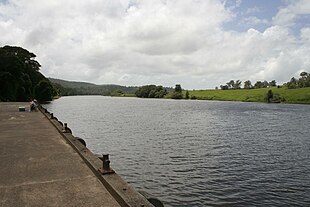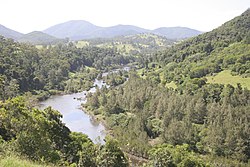|
Manning River
Manning River (Biripi: Boolumbahtee[1]), an open and trained mature wave dominated barrier estuary,[5] is located in the Northern Tablelands and Mid North Coast districts of New South Wales, Australia. It is the only double delta river in the southern hemisphere in which there are two permanent entrances to the river, one at Old Bar and another at Harrington, and is famously one of only two rivers in the world to have permanent multiple entrances with the other being the Nile river in Egypt.[6] Course and features Manning River rises below Mount Barrington, on the northeastern slopes of the Great Dividing Range within Barrington Tops National Park, east southeast of Ellerston, and flows generally southeast, joined by eleven tributaries including the Pigna Barney, Barnard, Nowendoc, Gloucester, Dawson, and Lansdowne rivers, descending 1,500 metres (4,900 ft) over its 261-kilometre (162 mi) course from the high upper reaches, through the Manning Valley, and out to sea.[4] The river flows past the towns of Wingham and Taree. At Taree, the river splits and becomes a double delta. The southern arm reaches its mouth at the Tasman Sea of the South Pacific Ocean, near Old Bar. The northern arm is joined by the Dawson River and further downstream the Lansdowne River, reaching its mouth at the Tasman Sea, near Harrington Point; creating two separate entrances to the river: Harrington Inlet (north) and Farquhar Inlet (south). Within the delta there are several channels dividing coastal land into large islands, such as Mitchells and Oxley islands. Between Croki (in the north) and Cabbage Tree Island east of Bohnock (in the south), Scotts Creek links both the northern and southern passages of the river. The Manning River is one of Australia's few large river systems that have not been dammed for water supply purposes anywhere along its catchment. The local water supply is fed by Bootawa Dam, which is an offsite dam, however, water is pumped from the river to the dam whenever river turbidity and flow levels can allow. A small weir is located in the upper reaches of the Barnard River, part of the inter-basin water transfer of the Barnard River Scheme, enabling water to be pumped into the Hunter River to meet the cooling needs of Bayswater and Liddell electric power stations.[7][8][9] The scheme is shut down until needed but as of 2006 this scheme was partly decommissioned due to its rare use.[citation needed] The Manning River is one of only a few Australian mainland rivers to receive annual winter melting snow deposits.[citation needed] The Manning River is variously traversed by the Pacific Highway between Taree and Coopernook, and the North Coast railway line at Taree. HistoryThe traditional custodians of the land surrounding the Manning River and its associated valley are the Australian Aboriginal Biripi,[10] who named the river as Boolumbahtee, meaning a place where the brolgas played.[1] In 1818, John Oxley crossed and named Harrington and Farquhar inlets during a trip from the Hastings River, near Port Macquarie, to Port Stephens. The Manning River itself was first surveyed by Henry Dangar in 1825 and again in 1826 on behalf of the Australian Agricultural Company. Later in 1826, the river was named the Manning River by Robert Dawson for the Deputy Governor of the Australian Agricultural Company, William Manning.[11] In the same year it was declared that the Manning was the northern limit of the Nineteen Counties, defining the areas of New South Wales where settlers were free to occupy. Until 1913, ships servicing the coast brought goods and supplies up the river. Wingham was established at the furthest point supply boats could reach up the river and became the region's major port. The old cargo wharf at Wingham Brush has since been refurbished. The town of Tinonee was also settled on the river near Taree. In 2008 a pod of bottle-nosed dolphins became stranded up stream from Wingham between Jackson and Abbotts Falls (visible from Brushy Cutting Lookout). Authorities observed, but did not intervene. Despite this area having adequate food, and a high level of water, all dolphins soon died stranded in this section of fresh and/or brackish water. This is assumed by specialists now to relate to low salinity water leading to Fresh Water Skin Disease. Necroscopys and water testing were not carried out. In March 2021, a record breaking low pressure trough brought intense rainfall to the Manning Valley catchment area,[12] inundating properties at Taree and Wingham. It peaked at 5.7 m (19 ft) in Taree, falling just short of the record 6 m (20 ft) flood of 1929.[13] In September 2023 a pod of five bottle-nosed dolphins became entrapped in a fresh water section of the Manning River, again between Jackson and Abbotts Falls. First observations reported one deceased dolphin, and the four surviving dolphins abnormal behaviour thrashing in deep sections of river and remaining circling within a small section of the river. Relevant authorities were notified. A period of observation of the dolphins was enacted. Water testing some days later revealed the water was fresh, and not brackish as had been presumed. Fresh Water Skin Disease quickly developed in all dolphins as a result of prolonged fresh water exposure.[14] Visual growths and deep lesions became evident, even from the shore, and the last surviving dolphins colours began to change. Rescue was formally enacted after three of the dolphins were found deceased.[15] The fourth dolphin perished the day following, before rescue could be enacted. A skilled multidisciplinary team, carried out a successful and humane capture of the only surviving dolphin on 17 September 2023.[16] Once captured, the final dolphin, who came to be known as Forest, was initially given medical clearance to travel to Sea World Foundation, QLD to be rehabilitated. On full recovery Forest would have been released locally in the Mid-Coast. Forest was sedated with specialist marine mammal vets and a team of volunteers alongside her. She was travelling in a specialty equipped veterinary vehicle and was under sedation with the specialist team all around her when she died. Necroscopy showed prolonged exposure to fresh water conditions led to array of major health concerns, ultimately organ failure (Fresh Water Skin Disease). The pod of five dolphins perished within 5.5- 13.5 days of becoming entrapped in fresh water conditions. This event is being used to better understand Fresh Water Skin disease internationally, and to support better outcomes if this happens again in this stretch of the Manning River. EcologyThe Manning River is a large producer of Australian oysters and is home to many fish, the most common being the Dusky Flathead (Platycephalus fuscus), a common Australian estuary fish. It is also a habitat for the endangered Manning River helmeted turtle, which is endemic to the upper and middle catchments.[17][18] The Manning River is frequented by dolphins and sharks, with some venturing as far up the river to Wingham. Whales also frequent the river, mainly at the larger Harrington Inlet, although some do enter the Farquar Inlet and generally do not venture far up river. However, on 16 September 1994 a rare tropical Bryde's whale measuring 9-metre (30 ft) long, nicknamed "Free Willy" by locals, ventured much further up river to Taree. After becoming a tourist attraction, and repeatedly evading attempts by conservationists to free him "Free Willy" was finally rescued by Seaworld Staff in conjunction with NSW National Parks And Wildlife and ORCA (Organisation for the Rescue and Research of Cetaceans in Australia). "Willy" became stranded on a sandbar, and with the assistance of a specially designed inflatable Cetacean Rescue Device, floated and towed back out to sea and was last seen heading for deeper water to the east.[19][20] Events and industryTaree is home to the annual Manning River Summer Festival, which features rowing, and sailing. The Taree Powerboat Club Spectacular is held in the Manning River during the Easter long weekend. The Manning Point Fishing Classic, held annually at Manning Point is the Australian leg of the Poissons et boisson extrêmes extreme fishing tour. The tour pits an invitation only collection of notorious fishers, known for their extreme dedication to the twin arts of fishing and drinking. Commercial fishing and oyster farming are both practiced in the Manning. The peak season for oyster production is September to March; and the annual production during 2013 was 146,000 dozen.[21] The link between Taree and the oyster industry is shown by the presence in Taree of the "Big Oyster", a building constructed in the shape of an open oyster shell. The Manning River area is popular for domestic tourism. See also
References
External linksWikimedia Commons has media related to Manning River.
|
||||||||||||||||||||||||||||||||||||||||||||||||||||||||||||||

